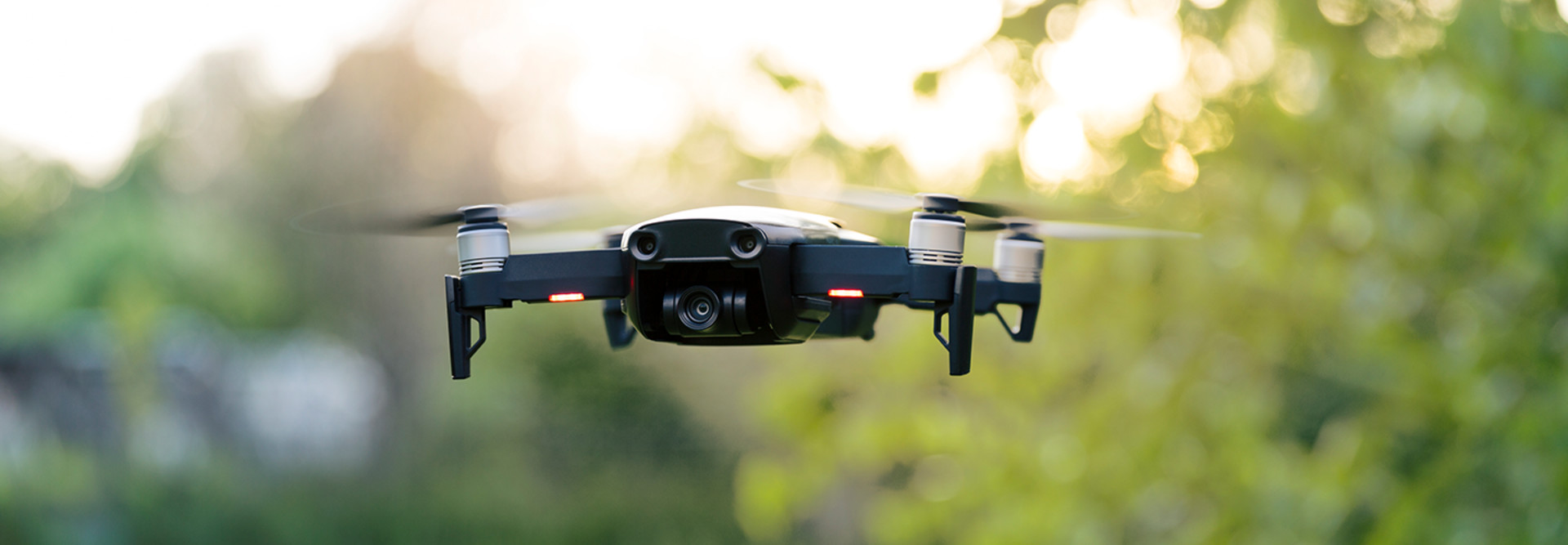Drones Take Flight on Campus for Teaching, Research and Administrative Tasks
Ten years ago, seeing a drone zoom over a college campus would have been unusual, to say the least. Today, however, several institutions are using the technology to support learning, research and even administrative work, such as capturing footage for a marketing video.
Unmanned aerial vehicles have been in use since the 1990s, primarily to support military, border security and other public operations, according to the Federal Aviation Administration. Consumer adoption began to accelerate a few years ago as hobby drones became more advanced and less expensive. From 2014 to 2017, consumer drone shipments jumped worldwide by 7 million units, according to a Business Insider Intelligence analysis.
That’s about when higher education institutions began to realize UAVs could play a role on campus, according to Venkata Krishnan Seshadri, industry lead at market research provider Technavio.
“Drones facilitate application-based, practical learning, which helps students understand and remember key theoretical concepts,” Seshadri says. “Using drones significantly reduces risks and costs. For instance, in archeological-related courses, drones are used to capture aerial imagery, which increases the quality of learning without safety issues.”
PRODUCT REVIEW: DJI Phantom 4 Pro+ Drone is an easy addition to a campus fleet.
Drones Offer Versatility for Multiple Campus Disciplines
Arthur Helmicki, a professor in the University of Cincinnati’s Department of Electrical Engineering and Computer Science, is investigating how the Ohio Department of Transportation might use drones to collect information that is logistically difficult to obtain and to improve operations — monitoring traffic patterns, for instance, or determining if an area has flooding erosion.
His team has used several models, including DJI’s M210 RTK and the Intel Falcon 8+ Drone - Topcon Edition.
“We have a fleet of several we’ve used right out of the box, and we’re configuring others to carry additional payloads,” Helmicki says. “Drones have a very multidisciplinary flavor, and that appeals to students and faculty. It’s not something any one discipline can claim it knows everything about.”
Equipping drones to gather specific types of data for a particular project may mean the devices need modification, says Helmicki. To do so, he recommends assembling a team with members from departments such as aerospace and mechanical engineering.
Battery life is another consideration. Helmicki’s project involves tethered drones that connect to a generator on the ground. That extends use beyond battery limitations — a challenge Colgate University encountered when creating a promotional video about students moving in.
Factoring in takeoff and landing, Colgate’s drone could fly for approximately eight minutes, so staff needed multiple flights to get footage of various locations. Even so, Director of Engagement and Support Ahmad Khazaee says drones were still more efficient than previous options.
“You can take aerial shots in a way that even five years ago would’ve been very expensive and difficult to do,” he says. “You can experiment and quickly see what the possibilities are, and it’s so much cheaper than paying to rent a plane and photographer.”
Campus Drone Uses Include Art, Agriculture and Archaeology
A few colleges, such as Oklahoma State University, the University of North Dakota and Idaho State University, have established courses or entire programs that center on drone use and creation.
Others use the technology to drive home concepts in the classroom. Journalism students at the University of Arizona, for instance, used drones to capture video of U.S. border region security. Students at Wellesley College carried out a mock rescue mission with a drone for a social justice, conflict and engineering course.
The devices also can be valuable research assistants. Oregon State University faculty used drones to inspect state bridges and wireless communication towers. Clemson University sponsored a study that monitored crop health with UAVs.
At DeSales University, drones became a standard part of student film work after Yuneec sent associate professor Chuck Gloman one of its H520 devices for a TV Technology magazine review he wrote in April 2018. Gloman tested the drone on the university’s Center Valley, Pennsylvania, campus, filming character introductions for a short film he’d written.
He was impressed by how steady the camera remained, providing clear, consistent shots despite strong winds during the three-day shoot. His experiment prompted DeSales to purchase one of Yuneec’s Typhoon models.
“Once you go drone, you’ll never go back,” Gloman says. “It provides an incredible look, actually coming down from the sky right to eye level.”
A University of Colorado Boulder initiative, Project Society, has given small seed grants to faculty in theater, dance and other departments who want to explore the social, ethical, political, economic and cultural implications of drones, says Project Society Codirector Lorraine Bayard de Volo, who also chairs the women and gender studies department at the university.
Grant recipients have purchased a variety of drones, including the DJI Phantom 3 Professional.
“We have an archeologist who can map archeological characteristics you can’t see from normal sight,” de Volo says. “We had another grant go to someone who wanted to experiment with how we might capture the soundscape of nature using drones.”
MORE FROM EDTECH: Check out 4 ways drones can make an impact on campus.
Hands-On Applications Fuel Higher Ed Interest in Drones
As of mid-2018, there were more than 1 million registered UAVs in the U.S., according to Federal Aviation Administration data. The agency predicts that will more than double to 2.4 million by 2022.
Federal regulations may govern the permissible height of a flight or call for drones to avoid large groups of people, so campus users should be aware of any restrictions. To ensure compliance, institutions may want to develop a policy that covers both FAA and campus requirements, says Seshadri, including designated areas and scenarios in which drones can be used.
“Flying a drone for work, as opposed to for fun, in most cases imposes additional rules related to certification and aircraft requirements,” he says. “Pilots should be trained and learn local flight paths and air space restrictions. To ensure adequate training is provided to gain a certification, universities largely rely on external providers.”
Although academic use is still in the early stages, according to Helmicki, drones’ ability to provide robust, hands-on experience is already fueling interest in bringing the technology into coursework and university-sponsored projects.
“They need to be studied: how to coordinate drones in high-traffic areas, the interaction of drones and people,” Helmicki says. “But drones have a ‘wow’ factor, so students really enjoy working with them. The sky’s the limit.”









